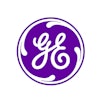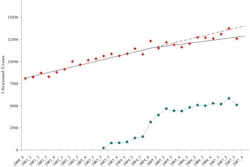Contrast-enhanced ultrasound of the spleen proved better than both CT and PET for staging nodules in patients with Hodgkin's lymphoma, according to a study published by Italian researchers in the May edition of Radiology.
Spleen involvement occurs in 10% to 30% of patients with Hodgkin's lymphoma, with staging usually performed by CT or PET, which are thought to be the most accurate modalities. Ultrasound without contrast has not typically been used for this application, according to the study team from the Federico II University Medical School in Naples.
Recent advances in ultrasound technology -- particularly tissue harmonic compound imaging and contrast -- are making the modality more competitive, however.
"Our study demonstrates that US with tissue harmonic compound technology and intravenous microbubble-based microvasculature study as part of the diagnostic workup to staging patients with Hodgkin's lymphoma allows for a more correct assessment of the spleen status, thus avoiding the risk of understaging, which may lead to undertreatment," the authors wrote.
The researchers sought to compare contrast-enhanced harmonic compound ultrasound, CT, and FDG-PET in detecting nodular infiltration in the spleen of patients with newly diagnosed Hodgkin's lymphoma. In the prospective study, 100 consecutive patients from January 2004 to December 2006 were investigated for possible spleen involvement using the three imaging modalities (Radiology, May 2009, Vol. 251:2, pp. 574-582).
Whole-body CT studies were performed on a LightSpeed Ultra scanner (GE Healthcare, Chalfont St. Giles, U.K.) using a gastrografin oral contrast agent (Lantheus Medical Imaging, North Billerica, MA) and 120 mL of Ultravist nonionic intravenous contrast (Bayer HealthCare Pharmaceuticals, Berlin). Whole-body FDG-PET was performed using a Discovery scanner (GE Healthcare).
Ultrasound was performed using an iU22 ultrasound scanner (Philips Healthcare, Andover, MA) equipped with SonoCT tissue harmonic compound imaging technology and a 2- to 5-MHz broadband curvilinear probe for the baseline study. When one or more possible nodules were detected in the study, nodule vascularization was assessed using SonoVue (Bracco, Milan, Italy).
All imaging studies were read by one of three investigators with more than 10 years of experience in CT, PET, and ultrasound. Each study was interpreted in a blinded fashion.
CT was able to detect malignant nodules in 13 patients, while FDG-PET also found malignant nodules in 13 patients. Contrast-enhanced harmonic ultrasound, however, detected malignant nodules in 30 patients.
Compared to contrast-enhanced harmonic compound ultrasound findings, the sensitivity of both CT and FDG-PET in detecting splenic malignancy was 43% (13 of 30; 95% CI, 0.26-0.62), yielding a false-negative rate of 57% (17 of 30; 95% CI, 0.38-0.74), according to the authors.
"Both CT and FDG-PET provided false-negative results in 17 of 30 patients compared with contrast-enhanced harmonic compound US, the results of which translated into disease upstaging in 13 patients," the authors wrote.
In other results, all three imaging techniques correctly classified 10 of the 13 patients with nodules greater than 1 cm. Three patients, however, had normal findings on both CT and FDG-PET. Of the 17 patients with nodules 1 cm or smaller, CT and FDG-PET identified lymphoma involvement in only three cases.
The researchers concluded that clinicians should not rely solely on conventional diagnostic procedures to exclude subdiaphragmatic disease in patients with newly diagnosed Hodgkin's lymphoma, given the possibility of cryptic nodular infiltration in spleens that appear negative on CT and FDG-PET studies.
"Harmonic compound US with contrast enhancement for the characterization of possible nodules provides a higher sensitivity than does CT or FDG-PET in the detection of splenic involvement by Hodgkin's lymphoma," the authors wrote.
By Erik L. Ridley
AuntMinnie.com staff writer
May 6, 2009
Related Reading
PET-based F-18 FLT equivocal for leukemia imaging, January 7, 2009
Contrast-enhanced US shines in solid organ injury imaging, October 5, 2006
Contrast-enhanced US picture shows signs of brightening, April 18, 2006
CEUS aids differentiation of small liver lesions, April 3, 2006
Copyright © 2009 AuntMinnie.com




















